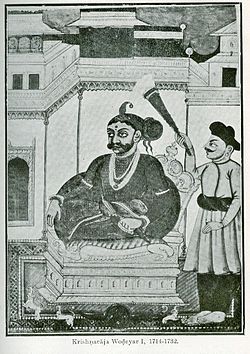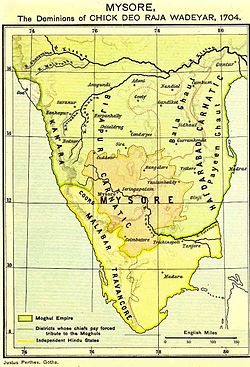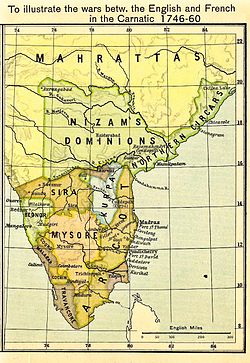- Dodda Krishnaraja I
-
Dodda Krishnaraja I was the wodeyar ruler (Raja) of Mysore, a petty kingdom in southern India. His reign lasted from 1714 to 1732 CE.
Contents
Personal life
Dodda Krishnaraja was born on 18 March 1702. He was the first born son of Kanthirava Narasaraja II, by his second wife Chelvaja Ammani Avaru. A month before his tenth birthday—upon his father's death—he acceded to the Mysore gaddi. Although he was married nine times, direct descent in the Wodeyar lineage stopped with him; a son was born to his first wife, but died aged six months. Dodda Krishnaraja died on 5 March 1732 at the age of 29, and was succeeded by an adopted son.
Demands of neighbors
Just before Dodda Krishnaraja's accession, a change had come in the governance of the Mughal Province of Sira (Carnatic Bijapur) to the north and northeast of Mysore.[1] In 1713, Carnatic-Bijapur was split into a payanghat jurisdiction with capital at Arcot and governed by a newly styled Nawab of Arcot, and a balaghat jurisdiction, governed by a newly-styled Nawab of Sira.[1] That same year, the governor of Carnatic-Bijapur, Sadat-ulla Khan, was made the new Nawab of Arcot, and Amin Khan was appointed Nawab of Sira;[1] Mysore, however, remained a formal tributary state of Sira. This division, and the resulting loss of revenue from the rich maidān region of Mysore, made Sadat-ulla Khan unhappy and, in collusion with the rulers of Kadapa, Kurnool, and Savanur and the Maratha Raja of Gutti, he decided to march against Dodda Krishnaraja.[1] However, the Nawab of Sira, anxious to preempt the coalition's action, hit upon a plan himself of reaching the Mysore capital, Seringapatam.[1] In the end, both Nawabs—of Arcot and Sira—settled upon a joint invasion led by the former.[1] Dodda Krishnaraja, for his part, was able to "buy off this formidable confederacy" by offering a tribute of Rs. 1 crore (10 million).[1] This outcome, however, made Mysore vulnerable to similar future claims, which, for example, were made successfully two years later by Maratha raiders who appeared in the Mysore capital.[1] The resulting depletion of the Mysore treasury, led Mysore to itself attack and absorb the poligar chiefdom of Magadi to its north.[1]
Abdication of power
Wilks 1811 gave a decidedly negative appraisal of the Raja's character:
"Whatever portion of vigour or of wisdom appeared in the conduct of this reign belonged exclusively to the ministers, who secured their own authority by appearing with affected humility to study in all things the inclinations and wishes of the Raja. Weak and capricious in his temper, he committed the most cruel excesses on the persons and property of those who approached him, and as quickly restored them to his favour. While no opposition was made to an establishment of almost incredible absurdity, amounting to a lac of rupees annually, for the maintenance of an almshouse to feed beasts of prey, reptiles, and insects ; he believed himself to be an unlimited despot ; and, while amply supplied with the means of sensual pleasure, to which he devoted the largest portion of his time, he thought himself the greatest and happiest of monarchs, without understanding, or caring to understand, during a reign of nineteen years, the troublesome details through which he was supplied with all that is necessary for animal gratification."
According to Rice 1897a, pp. 370, the Raja's lack of interest in the affairs of state, soon led two ministers, Devaraja, the army chief (or delavayi), and his cousin, Nanjaraja, who was both the revenue minister (the sarvadhikari) and the privy councilor (pradhana), to wield all authority in the kingdom. After Dodda Krishnaraja's death in 1736, the ministers would appoint "pageant rajas," and effectively rule Mysore until the rise of Haidar Ali in 1760.
See also
- Province of Sira
- History of Mysore and Coorg, 1565–1760
Notes
References
- Imperial Gazetteer of India: Provincial Series (1908), Mysore and Coorg, Calcutta: Superintendent of Government Printing. Pp. xvii, 365, 1 map., http://books.google.com/books?id=lgO2AAAAIAAJ&printsec=titlepage&source=gbs_summary_r&cad=0
- Rice, Lewis (1897a), Mysore: A Gazetteer Compiled for the Government, Volume I, Mysore In General, Westminster: Archibald Constable and Company. Pp. xix, 834, http://books.google.com/books?id=kbQLAAAAIAAJ&printsec=toc&source=gbs_summary_r&cad=0#PPR3,M1
- Rice, Lewis (1897b), Mysore: A Gazetteer Compiled for the Government, Volume II, Mysore, By Districts, Westminster: Archibald Constable and Company. Pp. xii, 581, http://books.google.com/books?id=FR1CAAAAIAAJ&printsec=titlepage&source=gbs_summary_r&cad=0
- Wilks, Mark (1811) [1st edition: 1811, volume 1; 1817, volumes 2 and 3; second edition: 1869]. Historical Sketches of the South of India in an attempt to trace the History of Mysoor, Second Edition. Madras: Higginbotham and Co. Pp. xxxii, 527. http://books.google.com/books?id=SlzbN6GpTTQC&printsec=titlepage&source=gbs_summary_r&cad=0.
Categories:- Kingdom of Mysore
- Kings of Mysore
Wikimedia Foundation. 2010.



